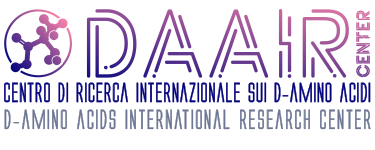Amyotrophic lateral sclerosis
Amyotrophic lateral sclerosis (ALS) is a frequent adult-onset neuromuscular disorder characterized by the selective degeneration of motor neurons in the spinal cord, brain stem and motor cortex, leading to fatal paralysis.
In a mouse system of ALS, namely the G93A mSOD1 strain, an increased level of D-serine in spinal fluid was observed (Sasabe et al., 2007; Thompson et al., 2012). This suggests that neurons from ALS are susceptible to NMDA-mediated excitotoxic damage: a putative mechanism for motoneuronal death in ALS is based on glutamate toxicity enhanced by D-serine overproduced in glia. Actually, increased levels of glial serine racemase and D-serine were observed with disease progression (Sasabe et al., 2007). Neuronal injury involving NMDA receptors overactivation in the cerebral cortex depended on supply of D-serine (which acts a glycine site agonist). Treatment with the enzyme deputed to D-amino acids degradation (D-amino acid oxidase, DAAO), by decreasing D-serine level, markedly inhibited neuronal damage (Katsuki et al., 2004). Indeed, hindering the enzyme deputed to D-serine production (serine racemase, SR) slowed disease progression (Thompson et al., 2012).
Substantial advances in understanding ALS disease mechanisms has come from the identification of pathogenic mutations in dominantly inherited familial ALS (fALS). The mutation yielding to the Arg199Trp substitution in the DAAO gene transmitted with the disorder was identified in a three generational fALS kindred (Mitchell et al., 2010). While the overexpression of wild-type human DAAO did not affect cell survival, overexpression of R199W DAAO in primary motor neuron cultures or motor neuron cell lines promoted the formation of ubiquitinated protein aggregates, activated autophagy and increased apoptosis (Paul and de Belleroche, 2012; Paul et al., 2014). Significant modifications in human DAAO protein conformation are evident following the R199W substitution: altered protein tertiary conformation and oligomeric state, lower protein thermostability, and lower affinity for the substrate D-serine. This substitution impaired the enzyme activity (Cappelletti et al., 2015). Based on structural analyses, it is conceivable that substitution at position 199 could significantly impact on the ability of the DAAO variant to stabilize the substrate binding. These pathogenic effects are mediated by the accumulation of the variant DAAO, but the neurotoxic effect also depends on increased D-serine due the impaired enzyme activity: co-culturing motor neurons with glial cells expressing R199W DAAO variant was sufficient to induce apoptosis in motor neurons, an effect reversed by the treatment with 5,7-dichlorokynurenic acid, an NMDA receptor antagonist selective for the D-serine/glycine site (Paul et al., 2014).
References
Cappelletti P, Piubelli L, Murtas G, Caldinelli L, Valentino M, Molla G, Pollegioni L, Sacchi S. Structure-function relationships in human D-amino acid oxidase variants corresponding to known SNPs. Biochim. Biophys. Acta (2015) 1854(9):1150-1159.
Katsuki H, Nonaka M, Shirakawa H, Kume T, Akaike A. Endogenous D-serine is involved in induction of neuronal death by N-methyl-D-aspartate and simulated ischemia in rat cerebrocortical slices. J. Pharmacol. Exp. Ther. (2004) 311:836–844.
Mitchell J, P. Paul, H.J. Chen, A. Morris, M. Payling, M. Falchi, J. Habgood, S. Panoutsou, S. Winkler, V. Tisato, A. Hajitou, B. Smith, C. Vance, C. Shaw, N.D. Mazarakis, J. de Belleroche, Familial amyotrophic lateral sclerosis is associated with a mutation in D-amino acid oxidase. Proc. Natl. Acad. Sci. U. S. A. (2010) 107:7556–7561.
Paul P, J. de Belleroche, The role of D-amino acids in amyotrophic lateral sclerosis pathogenesis: a review. Amino Acids (2012) 43:1823–1831.
Paul P, T. Murphy, Z. Oseni, S. Sivalokanathan, J.S. de Belleroche, Pathogenic effects of amyotrophic lateral sclerosis-linked mutation in D-amino acid oxidase are mediated by D-serine. Neurobiol. Aging (2014) 35:876–885.
Sasabe J, Chiba T, Yamada M, Okamoto K, Nishimoto I, Matsuoka M, Aiso S. D-serine is a key determinant of glutamate toxicity in amyotrophic lateral sclerosis. EMBO J. (2007) 26:4149–4159.
Thompson M, Marecki JC, Marinesco S, Labrie V, Roder JC, Barger SW, Crow JP. Paradoxical roles of serine racemase and D-serine in the G93A mSOD1 mouse model of amyotrophic lateral sclerosis. J. Neurochem. (2012) 120(4):598-610.
Author
Loredano Pollegioni, Università degli studi dell’Insubria
